How to play rhythm guitar – a brief guide to the techniques and skills you’ll need to master to become a great rhythm guitarist…
While it’s easy for us as guitar players to get caught up in the glamorous world of lead playing, the truth is that rhythm guitar is just as–if not more–important in most guitar-based music.
You can find out more about lead guitar playing on this page: How To Play Lead Guitar
Rhythm guitar provides the backbone of most rock songs, providing a link between the drums and the melody.
In other genres, the rhythm guitar adds important harmonic and rhythmic elements to a song's musical backing, which may also include keyboards and other instruments.
In acoustic folk music, the rhythm guitar might provide the sole instrumental backing for a singer.
Being able to play good rhythm guitar is, therefore, an essential skill for a guitarist in any genre.
What Is Rhythm Guitar?
Think of music as having layers. There’s a rhythmic layer, a harmonic layer, and a melodic layer.
The rhythmic layer of a typical song is chiefly occupied by the drums, while the melodic layer is provided by the lead vocals, or, during an instrumental break, by an instrument such as a lead guitar, synth or sax.
Although the melodic layer is the “focal point” of the music, without chords to provide a harmonic context, it would sound incomplete.
The rhythm guitar provides the harmonic layer that supports the melody. In a typical guitar band, this role is shared with the bass, which supplies the “low end” of the harmonic layer.
Whereas a bassist will usually play single notes to provide the basic harmonic element of a song, a rhythm guitarist will usually play chords.
The additional notes contained in guitar chords complete the song’s harmonic layer, harmonizing the melody line and giving it musical context.
Because guitar chords are usually strummed rhythmically, rhythm guitar not only provides a song’s harmonic layer, but also embellishes the rhythmic layer.
What Does A Rhythm Guitarist Do?
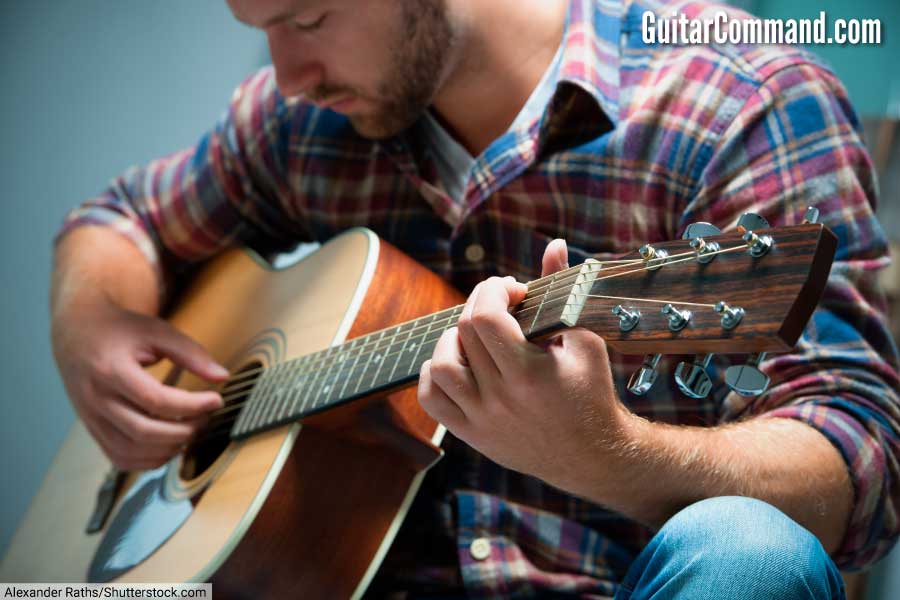
A rhythm guitarist plays chords using rhythmic strumming patterns, providing both harmonic and rhythmic backing to a song’s melody line.
In addition, a rhythm guitarist will often be responsible for playing riffs or arpeggios that provide instrumental backing for the vocals or other lead line.
In a single song, a rhythm guitarist might: play an intro riff, play chords for the verse and chorus, play the original riff again, play another riff or more chords while the lead guitarist takes a solo, play the chorus chords again, then finish the song by playing the main riff again.
Great rhythm playing requires a working understanding of chord theory, a broad chord vocabulary, a good “feel” or sense of rhythm, and the ability to utilise a variety of playing techniques, including various strumming styles.
Chord Progressions

A chord progression, or chord sequence, is essentially a list of chords in a song (or part of a song).
A song is usually divided into sections, e.g., verse, chorus, bridge, etc., some of which may be played more than once.
A song’s chord progression may therefore be broken up into shorter chord progressions for each section.
A verse, for example, might have a chord progression of A minor, F major, C major, and D major, perhaps played for one bar each.
The different sections of a song usually have different chords, although sometimes a song’s verse, chorus, and other sections may have the same, or similar, chord progressions.
Do You Have To Read Music To Play Rhythm Guitar?
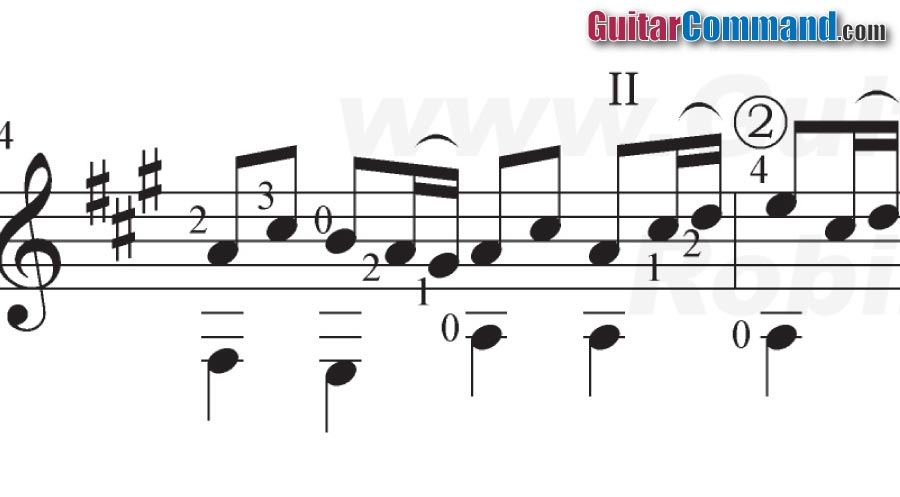
You don’t have to be able to read music to play rhythm guitar. Rhythm guitarists often simply follow chord charts, which contain the song’s chord progression written as a sequence of chord symbols (see below).
In sheet music, a song’s chords are often written above the main melody line. The chords may be written as chord symbols, chord diagrams, or both.
Guitar chords are rarely written in traditional musical notation.
Types Of Chords
There are many different types of chord, but on this page we’ll concentrate on the basic, “building-block” chords: the major, minor and (dominant) seventh chords.
- Major chords have a cheerful, optimistic sound;
- Minor chords have a sad, somewhat dark sound;
- Dominant seventh chords have an “expectant” sound.
As you learn more about rhythm guitar playing, you’ll come across a wide variety of other chords. Most of them will, however, will essentially be variations on the three chords listed above, with extra notes added to provide different colors to the chord’s sound.
Basic Guitar Chord Symbols
A guitar chord symbol consists of a letter, which is the “root note” of the chord, usually followed by a variety of other numbers and musical symbols.
Major Chord Symbol
A guitar chord symbol with a single capital letter represents a major chord with that root note (e.g., the symbol “C” represents a C major chord).
Minor Chord Symbol
A letter (capital or lower case) followed by a lower case “m” denotes a minor chord (e.g., the chord symbol Cm represents a C minor chord).
Dominant Seventh Chord Symbol
A capital letter followed by a “7” represents a dominant 7th chord (e.g., the chord symbol “C7” represents a C dominant seventh, or C seven chord).
Selecting The Right Chord
A chord symbol simply tells you what chord to play; it doesn’t tell you how to play it!
In nearly every case, there are multiple ways of playing the same type of chord.
For example, a C major chord can be played in open position, or as a barre chord (see below) at numerous positions on the fretboard.
As a rhythm guitarist, it’s up to you to select a suitable way of playing the chords you see on a chord chart.
For example, that could mean: selecting the easiest way of playing a chord; selecting the best-sounding way of playing a chord; selecting a chord shape close to the previous chord on the fretboard; or selecting the only way you know of playing the chord!
Part of the secret of being a good rhythm guitarist is being able to select the most appropriate chord for any given situation.
Get A Good Chord Book!

If you want to get started playing rhythm guitar, then getting hold of a good guitar chord reference book is essential.
We recommend our very own chord book, imaginatively entitled "Guitar Chord Book", which contains all of the chords a guitarist is ever likely to need, from basic major, minor and seventh chords, through to complex altered jazz chords.
You can check out the print version on this page: Guitar Chord Book.
You can also download the book as a printable pdf eBook: Guitar Chord Book Printable PDF eBook
Open Chords
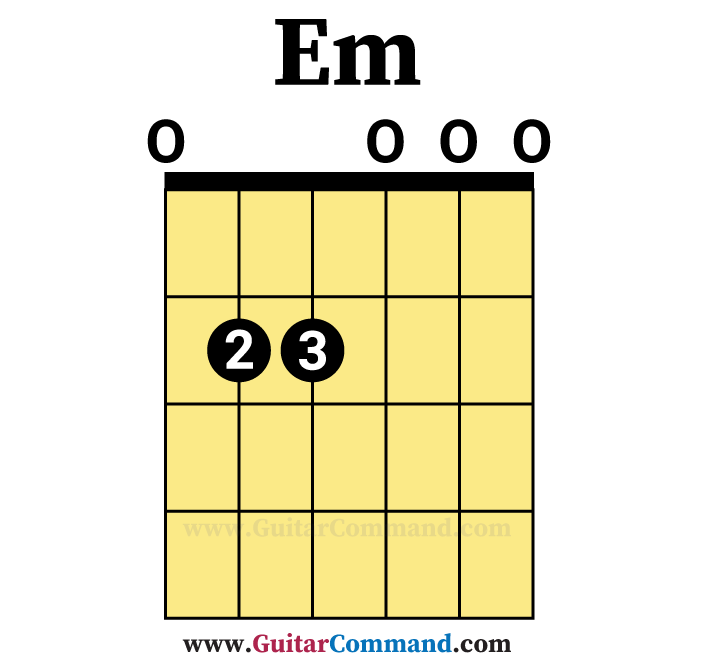
Open chords are guitar chords that contain open (unfretted) strings. The open chord for E minor, shown above, contains four open strings: bottom E, G, B, and top E.
Barre Chords
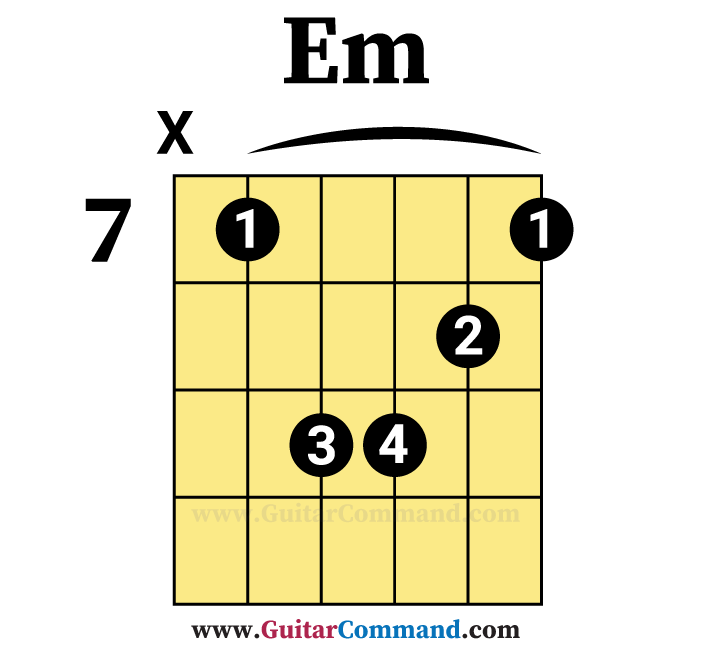
Barre chords require you to use one finger (most often the index finger) to press down on multiple strings across a single fret on your fretboard.
The basic “shapes” you learn to play open chords are also used in barre chords.
Essentially, the barre replaces the guitar nut, allowing you to play chords further up the fretboard.
Barre chords make it easy to play major and minor chords, as well as extensions including sevenths, sixths, and ninths.
Although they can seem intimidating to the beginner, barre chords are extremely useful for playing songs on the fly, because you only need to know a single “shape” that you can move across the entire fretboard.
For example, the same barre chord shape that can be used to play a G major chord at the 3rd fret can be moved up two frets to the 5th fret in order to play an A major chord.
Chords that can be moved this way (i.e. nearly all barre chords, plus other chords that don’t contain open notes) are also known as “movable chords”.
Jimi Hendrix and Keith Richards are great examples of guitar players who use barre chords for innovative, engaging rhythm guitar playing.
Guitar Chord Diagrams
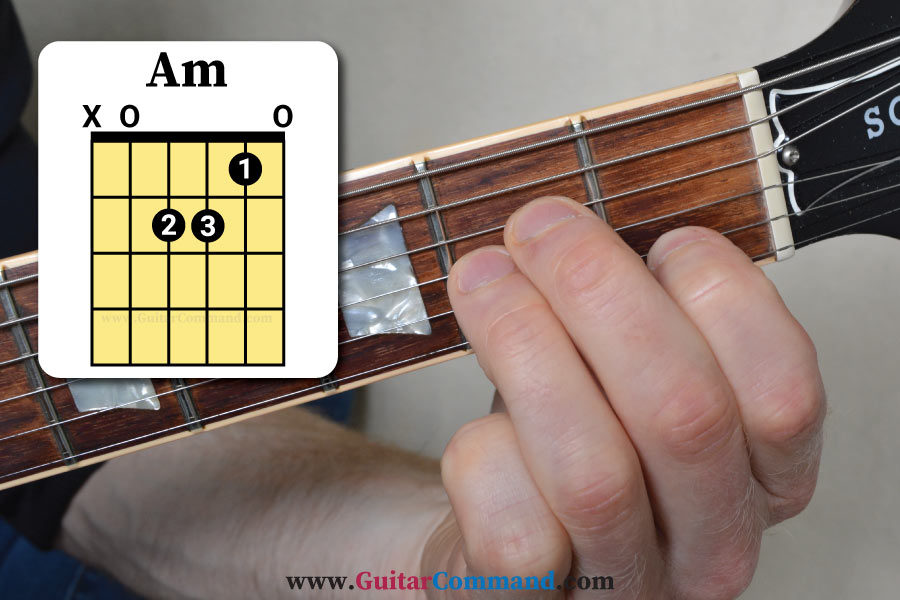
Most guitar chord books contain guitar chords written in diagram form. Sheet music too will sometimes contain not only chord symbols, but also chord diagrams.
Guitar chord diagrams may vary slightly from one publication to the next, but the basic idea behind them is the same, and you should learn to read them.
Chord diagrams are “box-shaped” and are therefore often known as “chord boxes”.
The “box” consists of six vertical lines. Each of these represents a guitar string, from lowest to highest pitch going left to right.
The thick line (if present) at the top represents the nut of your guitar, otherwise a number outside of the chord box will tell you at which fret the chord should be played.
The horizontal lines represent the frets on a guitar. The dots represent where your fingers sit to play the chord. Sometimes, a diagram will have numbers along the bottom letting you know which finger you’re fretting with.
Roman Numeral Chord Notation

One way musicians communicate different chord progressions is by using Roman numerals.
Each of the seven diatonic chords in a key is allocated a Roman numeral based on the root note’s position in the scale.
In the key of C major, for example, the C chord is designated the number I (1), the D minor chord is designated number ii (2), the E minor chord is number iii (3), and so on.
In this system, 1, 4, and 5 are always major; 2, 3, 6, are always minor, and 7 is diminished.
The minor chords are often written in lowercase (ii, as opposed to II).
Therefore, in the key of C major, the I chord is C major and the ii chord is D minor.
In the key of G major, the I chord is G major and the ii chord is A minor.
Common progressions include I/V/vi/IV, ii/V/I, and I/IV/V. You should learn these in various keys.
By referring to chords in this manner, musicians can learn and communicate the harmonic structure of a song without referring to the actual chords.
You can find out more about another common progression, the ii V I progression, on this page: 2 5 1 Progression Explained
Guitar TAB
Guitar tablature (often abbreviated to “tab”) is also occasionally used for chords. Tab notation is a representation of guitar strings.
Tab comprises six horizontal lines, each corresponding to a string on your guitar.
The bottom line is the lowest pitched (thickest) string. The top line is the highest pitched (thinnest) string. In standard tuning, from bottom to top, the strings are E, A, D, G, B, and E.
Each number on the tab represents the fret on that string you’re playing.
Tabs don’t tell you which note to play, instead they tell you at which fret to play (which amounts to the same thing!).
You can find out more about guitar tab on this page: What is Guitar Tab?
Rhythm Guitar Playing Techniques
To become a great rhythm guitar player, there are a number of techniques you’ll have to learn.
Strumming Chords
Most rhythm guitarists play chords by strumming the strings with a pick.
Strumming involves sounding all of the notes of a chord in quick succession by moving the pick quickly across the desired strings.
Although, strictly speaking, the pick can only play one note at a time, moving the pick quickly across the strings gives the impression that all of the notes of the chord are being played simultaneously.
Some chords require all six guitar strings to be played in a strum. Others require certain strings to be omitted from a strum. The string or strings to be omitted will usually be bass strings, so simply start your strum from the first note of the chord, rather than from the bottom string.
Strings to be omitted from a chord are marked with an “X” on the chord diagram.
Basic strumming is an easy skill to pick up.
Downstrokes & Upstrokes
Usually, you’ll start strumming with a downstroke (strumming from the bass strings to the treble strings with a downward motion), but upstrokes (strumming the strings in a upwards direction) can also be used.
Strumming Patterns

You don’t normally strum chords with a single downstroke on every beat. That would sound very monotonous, and wouldn’t add much rhythmic drive to the song.
Instead, rhythm guitarists usually strum chords using a combination of downstrokes and upstrokes. They don’t necessarily strum on every beat, and also add one or more strums between the beats. This provides not only harmonic interest, but also rhythmic interest to a song.
The combination of up and down-strokes, and the rhythm in which they are played, is known as a strumming pattern.
Coming up with a suitable strumming pattern will soon become second nature as you progress on rhythm guitar.
You can find out more about strumming patterns on this page: Strumming Patterns For Guitar
Play the Rest
The rhythmic effect of strumming patterns is due not only to the chords, but also to the spaces between the chords.
Rhythm guitar strumming patterns can be often be improved by playing less, rather than more.
Think of the opening notes to AC/DC’s “Highway to Hell”. It starts with three strummed A chords, and then three beats of silence before you hear the guitar again. Those three beats are rests.
Don’t simply stop playing for the rest. Keep count in your head or by tapping your foot so you’re ready to lock in when your guitar part comes back in. You can “play” the rest by adopting some damping techniques.
The strummed intro to Oasis’ “Wonderwall” is another example of how a well-chosen strumming pattern becomes a part of the song, rather than just a collection of chords.
You can control how long a guitar chord sounds using a variety of methods.
Rhythmic Damping
You can control the length of the chord you’re playing by damping the notes with either hand, or even both.
Sometimes, you want the chord to ring out until it naturally decays and becomes quieter, gradually fading into silence.
However, when you’re quickly switching chords or playing more staccato rhythms, you’ll want to stop the chord earlier.
You can do this by lightly lifting your fingers off the frets – not totally, but enough to cut off the note.
You can also adopt a technique (as perfected by Malcolm Young of AC/DC) that involves using the edge of the right hand to mute chords exactly on the beat. (You can hear this on AC/DC’s “Highway to Hell”, or in the staccato opening riff to “Back in Black”.)
Palm Muting With Picking Hand
A related muting technique involves using the edge of the picking hand to lightly press on the string near the bridge, thereby inhibiting the strings from ringing. This results in your strums having a more percussive, rhythmic sound.
You can adjust the amount of pressure applied in order to create the desired sound.
Palm muting is used extensively in heavy metal rhythm guitar playing.
Playing Guitar Chords As Arpeggios
Chords were made to be broken! You don’t have to strum chords – you can also play the notes within a chord one at a time, creating what is known as a “broken chord”, or arpeggio.
This technique is often used in folk music and rock ballads. It’s also used in more up-tempo songs, a famous example being the main guitar riff in “Every Step You Take” by The Police.
Alex Lifeson of Rush is known for his innovative use of arpeggios. In the verse of “Spirit of Radio”, he strums the lower notes of a chord, then arpeggiates the remaining notes.
How To Play Rhythm Guitar: Conclusion
On this page you've learned about the rhythm guitarist's role in a band and how guitar chords are typically played and written.
Now you know what is involved in rhythm guitar playing, it's time to learn a few chords and experiment with some simple strumming patterns.
The first steps are always the hardest, but you'll soon get used to playing chords, following chord charts and accompanying other musicians.
By combining your new chord playing skills with a selection of riffs, you could be playing rhythm guitar in a band in no time!
If you have any questions on any aspects of rhythm guitar playing, feel free to ask us in the comments section below – we'll be happy to help!


